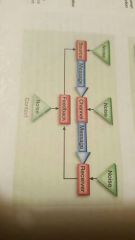![]()
![]()
![]()
Use LEFT and RIGHT arrow keys to navigate between flashcards;
Use UP and DOWN arrow keys to flip the card;
H to show hint;
A reads text to speech;
38 Cards in this Set
- Front
- Back
|
Impersonal Communication |
A type of communication or interaction that is based specifically on social roles, such as communication between a sales representative and a potential customer. The manner of communication is informal and superficial, covering topics necessary to instigate a sale or similar transaction. |
|
|
Interpersonal Communication |
|
|
|
Mediated Interpersonal |
Communication that is not |
|
|
Social Information-Processing Theory |
Theory that suggest people can communicate relational and emotional messages via the internet, although such messages take longer to express without Mon verbal cues |
|
|
Communication Models & Components- Channel |

Feedback Receiver Context Source |
|
|
Feedback |
The response to a message like a pecan game messages bounce back and forth we talk some of lessons and response we listen and respond to that response. For every action there is a reaction |
|
|
Receiver |
The person or people who interpret the message and ultimately determine whether your message was understood and appropriate. The listener ultimately make sense of the message that Express |
|
|
Context |
The physical and physiological environment for the conversation. The environment can determine the type of conversation |
|
|
Source |
The originator of the idea are feeling expressed this person puts the message into code process is called and coding |
|
|
Social Learning Theory |
He Siri that suggest people can learn behavior that helps them adopted and adjust their behavior towards others |
|
|
Self Concept |
A person's subjective description of who he or she is. A healthy self concept is flexible |
|
|
The three selves |
Material self - this says we are what we have Social self- this is the part of you that interact with other people Spiritual self - this consist of all your thoughts and introspections about your values and morals standards |
|
|
Social Penetration Model |
Of theory of relational development posits that increases in intimacy are connected to increases in self disclosure |
|
|
Johari Window |

The summer rises how your awareness of who you are is influenced by your level of disclosure as well as by how much information others sure about you with you |
|
|
Dyadic Effect |
This happens when two people disclose information. When one disclose is information the other disclosures information as well |
|
|
Self-Worth |
Your evaluation of your worth or value based on your perception of such things as your skills, abilities, talents, and appearance. Commonly used interchangeable with self esteem |
|
|
Schultz’s three primary social needs |
Need for control, need for inclusion, and need for affection or openness |
|
|
Self-Disclosure |
Purposely providing information about yourself to others that they would not learn if you did not tell them. Personal information disclosed to get to know somebody |
|
|
3 Stages of Interpersonal Perception |
Stage 1 selecting this is when we select what we paid tension to and what we get from that information this is also where thin slicing comes in we select what information about somebody we're going to judge that long. Stage 2 organizing this is one we take the information in and organize it and I brain we can create categories this is also the stage where we see closure the most. Stage 3 interpreting once we have selected in organized stimuli when next typically interpret the stimuli |
|
|
Recency |
Tendency to attend to the most recent information observed about another person and order to form or modify and impression |
|
|
Halo Effect |
Attributing a variety of positive qualities to those you like. Well really like someone and in our eyes they can do no wrong |
|
|
Horn Effect |
Attributing a variety of negative qualities to those you dislike. One you only can see the bad side of somebody |
|
|
Attribution Theory |
The theory that explains how we generate explanations for peoples Beaver |
|
|
Implicit personality Theory |
You unique set a behaviors and hypotheses about what people are like |
|
|
Causal Attribution Theory |
Theory of active you soon that identifies the cause of a person's actions as circumstances, a stimulus, or the person and sell for self |
|
|
Standpoint Theory |
The Siri lot a person's social position, power, or cultural background influences how the person receives the behaviors of others |
|
|
Barriers to Accurate Interpersonal Perception |
We stereotype we ignore information we impose consistency we focus on the negative we blame others we avoid responsibility |
|
|
Gender |
We first to the physiological in emotional characteristics. Cause people to assume masculine or feminine or androgynous (having a combo of both) roles |
|
|
Race and Ethnicity |
Race is based on the genetically transmitted physical characteristics of a group of people who are also classified together because of the, history, nationality, or geographical location. Ethnicity is a social classification based on a variety of factors, such as nationality, religion, language and insist real heritage, that are should buy a group of people who also share a common geographical origin |
|
|
Third Culture |
This is created when the communication partners join aspects of separate cultures to create a third new culture this is more comprehensive and inclusive then either of the two separate cultures |
|
|
Individualism & Collectivism |
This is two different ways that people live, America focus is more individualism because we focus on ourselves we make money for ourselves we focus on teaching our children how to be independent. Where other cultures such as China are more collectivist because they focus on a whole there children are raised knowing that they will need to take care of their parents when they are old and taught how to on for a whole group |
|
|
Feminine Cultures |
Feminine culture is not based on their being females but are based on softer characteristics such as caring for the less fortunate, being sensitive towards other and in reaching overall quality of life |
|
|
Uncertainty Reduction Theory |
Siri that cleans people seek information and order to reduce uncertainty, this achieving control and predictability |
|
|
MasculineCultures |
People from a masculine culture 10 to value more traditional rolls for both men and women masculine cultures also value achievement, assertiveness, heroism,and material wealth |
|
|
Culture |
Call learn system of knowledge, behavior, attitudes, believe, values and norms that is shared by group of people |
|
|
Enculturation |
The process of trying to meeting a groups culture from one generation to the next |
|
|
Social Decentering |
Hey cognitive process and which you take into account the other person's thoughts, value of, backgrounds, overall perspective. The greater the difference between you and another person the more difficult it is to accomplish social d |
|
|
Ethnocerism |
Stems from a conviction letter on cultural tradition and assumptions are superior to those of others it is the opposite of a other orientation that embrace and appreciates the elements that give other culture meaning |

